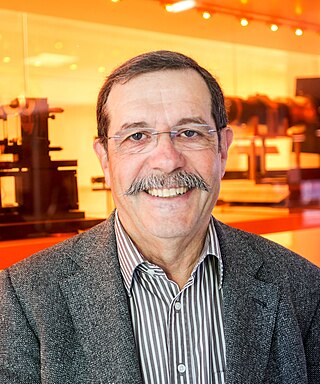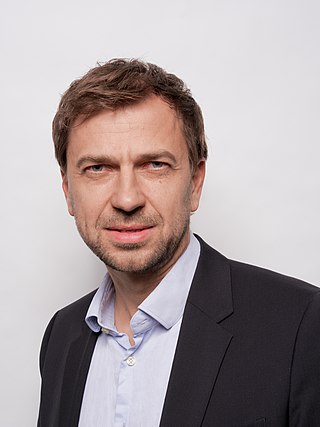Related Research Articles

John Stewart Bell FRS was a physicist from Northern Ireland and the originator of Bell's theorem, an important theorem in quantum physics regarding hidden-variable theories.
Quantum optics is a branch of atomic, molecular, and optical physics dealing with how individual quanta of light, known as photons, interact with atoms and molecules. It includes the study of the particle-like properties of photons. Photons have been used to test many of the counter-intuitive predictions of quantum mechanics, such as entanglement and teleportation, and are a useful resource for quantum information processing.
A Bell test, also known as Bell inequality test or Bell experiment, is a real-world physics experiment designed to test the theory of quantum mechanics in relation to Albert Einstein's concept of local realism. Named for John Stewart Bell, the experiments test whether or not the real world satisfies local realism, which requires the presence of some additional local variables to explain the behavior of particles like photons and electrons. As of 2015, all Bell tests have found that the hypothesis of local hidden variables is inconsistent with the way that physical systems behave.

Anton Zeilinger is an Austrian quantum physicist and Nobel laureate in physics of 2022. Zeilinger is professor of physics emeritus at the University of Vienna and senior scientist at the Institute for Quantum Optics and Quantum Information of the Austrian Academy of Sciences. Most of his research concerns the fundamental aspects and applications of quantum entanglement.

Alain Aspect is a French physicist noted for his experimental work on quantum entanglement.

Rainer Blatt is a German-Austrian experimental physicist. His research centres on the areas of quantum optics and quantum information. He and his team performed one of the first experiments to teleport atoms, the other was done at NIST in Boulder Colorado. The reports of both groups appeared back-to-back in Nature.

Peter Zoller is a theoretical physicist from Austria. He is professor at the University of Innsbruck and works on quantum optics and quantum information and is best known for his pioneering research on quantum computing and quantum communication and for bridging quantum optics and solid state physics.

Juan Ignacio Cirac Sasturain, known professionally as Ignacio Cirac, is a Spanish physicist. He is one of the pioneers of the field of quantum computing and quantum information theory. He is the recipient of the 2006 Prince of Asturias Award in technical and scientific research.

The Max-Planck-Institute of Quantum Optics is a part of the Max Planck Society which operates 87 research facilities in Germany.
The Institute for Quantum Optics and Quantum Information (IQOQI) (German: Institut für Quantenoptik und Quanteninformation) is a member institute of the Austrian Academy of Sciences and was founded in November 2003, to create an Austrian research center for the newly developing fields of theoretical and experimental quantum optics and quantum information.

Hans Jürgen Briegel is a German theoretical physicist. He is Full Professor at the University of Innsbruck and conducts research in the field of quantum physics and quantum information.
Daniel M. Greenberger is an American quantum physicist. He has been professor of physics at the City College of New York since 1964. He is also a fellow of the American Physical Society and—alongside Anton Zeilinger—founded the APS Topical Group on Quantum Information.
The Hamburg Centre for Ultrafast Imaging (CUI) is a research facility established in the context of the Universities Excellence Initiative by the German Federal and State Governments. The multidisciplinary and interinstitutional cluster is located at Universität Hamburg, Hamburg, Germany, and has been initiated on 1 November 2012. The funding with more than €25 million by the German Research Foundation will run until 31. December 2018. Scientific teams cooperating in the cluster come from the Universität Hamburg, the Deutsches Elektronen-Synchrotron (DESY), the European XFEL GmbH (XFEL), the European Molecular Biology Laboratory (EMBL), and the newly founded Max-Planck-Institute for the Structure and Dynamics of Matter (MPSD). A full application for a second research period of seven years was handed in at the end of 2017 to the German Research Foundation (DFG) for discussion. After the successful application in 2018, the new cluster “CUI: Advanced Imaging of Matter” started in 2019.

Nicolas Gisin is a Swiss physicist and professor at the University of Geneva, working on the foundations of quantum mechanics, quantum information, and communication. His work includes both experimental and theoretical physics. He has contributed work in the fields of experimental quantum cryptography and long-distance quantum communication over standard telecom optical fibers. He also co-founded ID Quantique, a company that provides quantum-based technologies.

Sandu Popescu is a Romanian-British physicist working in the foundations of quantum mechanics and quantum information.

Michel Devoret is a French physicist and F. W. Beinecke Professor of Applied Physics at Yale University. He also holds a position as the Director of the Applied Physics Nanofabrication Lab at Yale. He is known for his pioneering work on macroscopic quantum tunneling, and the single-electron pump as well as in groundbreaking contributions to initiating the fields of circuit quantum electrodynamics and quantronics.
Marek Żukowski is a Polish theoretical physicist and lecturer at the University of Gdańsk. He specializes in quantum mechanics, his area of interest in particular concerns the Bell's theorem and quantum interferometry.
John M. Martinis is an American physicist and a professor of physics at the University of California, Santa Barbara. In 2014, the Google Quantum A.I. Lab announced that it had hired Martinis and his team in a multimillion dollar deal to build a quantum computer using superconducting qubits.
Barbara Kraus ) is an Austrian physicist specializing in quantum information, quantum entanglement, and quantum key distribution. She is a University Professor at the TUM School of Natural Sciences at the Technical University of Munich.

Wolfgang Lechner is a theoretical physicist from Austria. He is the co-founder and co-CEO of the company ParityQC and professor at the Institute for Theoretical Physics of the University of Innsbruck.
References
- ↑ "John Stewart Bell Prize for Research on Fundamental Issues in Quantum Mechanics and Their Applications". University of Toronto Centre for Quantum Information and Quantum Control (CQIQC). Archived from the original on 4 June 2014. Retrieved 23 September 2014.
- ↑ "Award Rules" . Retrieved 3 July 2017.
- ↑ "Selection Committee" . Retrieved 3 July 2017.
- ↑ "University of Toronto". Archived from the original on 29 August 2019. Retrieved 21 October 2019.
- ↑ "2009 John Stewart Bell Prize". Archived from the original on 22 June 2017. Retrieved 3 July 2017.
- ↑ "2011 John Stewart Bell Prize". Archived from the original on 28 November 2016. Retrieved 3 July 2017.
- ↑ Eric Gershon (1 August 2013). "For two Yale quantum physicists, an honor from the north". Yale News. Yale University . Retrieved 24 September 2014.
- ↑ "Physiker Rainer Blatt erhält Forschungspreis" [Physicist Rainer Blatt receives research prize] (in German). Österreichischer Rundfunk. 17 August 2015. Retrieved 17 August 2015.
- ↑ "Ronald Hanson, Sae-Woo Nam and Anton Zeilinger awarded the Fifth Bell Prize". University of Toronto. Retrieved 4 October 2022.
- ↑ "John Stewart Bell Prize for Research on Fundamental Issues in Quantum Mechanics and Their Applications: Ignacio Cirac and Peter Zoller". University of Toronto. Retrieved 8 December 2019.
- ↑ "John Stewart Bell Prize for Research on Fundamental Issues in Quantum Mechanics and Their Applications: John Martinis". University of Toronto. Retrieved 3 May 2021.